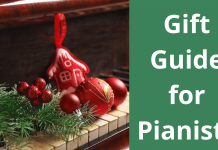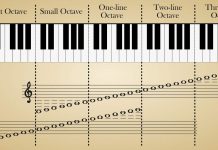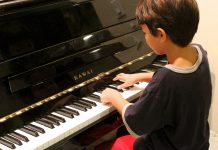Everybody is familiar with a piano’s sweet, round, and rich sound. But did you know this percussion instrument consists of multiple components? For instance, a piano has over 250 strings, while a guitar only has 6. In this article, you’ll discover the anatomy of a piano, including different piano parts.
Upright Piano
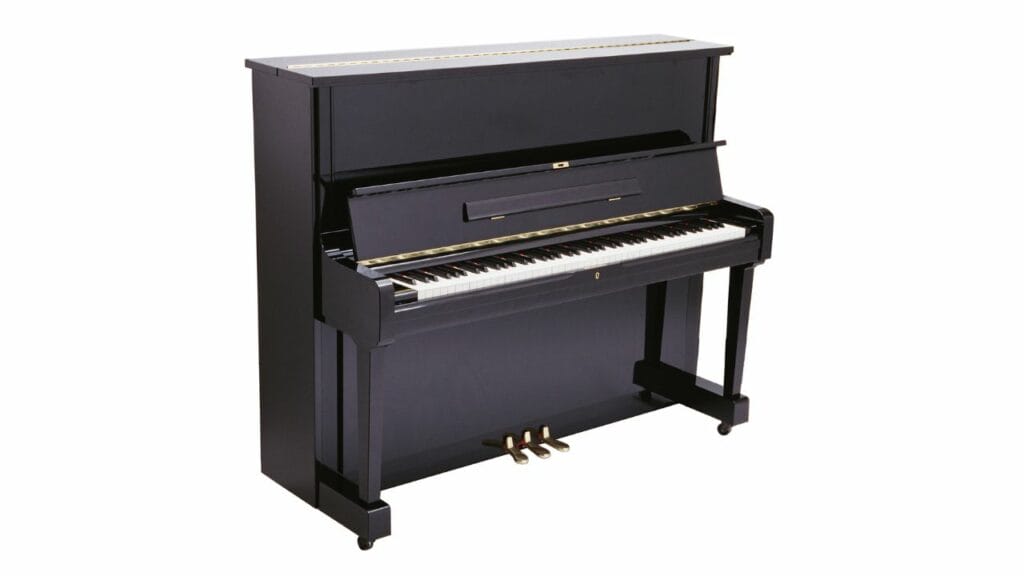
Grand piano parts are made of three components: a stringing system, a soundboard assembly, and a cast iron plate–also known as a harp–on which the strings rest. Upright pianos have a similar, but slightly different, stringing system attached to a cast iron plate supported by the soundboard assembly.
Piano Keys / Keyboard
The piano keys (white and black keys) are one of the most recognizable piano parts. What are piano keys made of? Early pianos used ivory for the white and ebony for the black keys. Today, modern pianos use plastic for both keys.
In an upright piano, you’ll notice that the keyboard is arranged in groups of three or four in a key block. Key blocks are grouped to form a piano key.
Soundboard
The soundboard of an upright piano is a rectangular wooden surface. Its purpose is to provide a resonating area for the strings to vibrate so the listener can hear them. The soundboard is reinforced with crossbeams and has small protrusions, called ribs, on which the strings are placed. The ends of the strings terminate in tuning pegs secured into holes underneath the soundboard.
Strings
The strings are the cords in the piano that are used to produce sound. There are two types of strings: piano string and high-tech. The piano string is made from steel and is smaller in diameter than the high-tech string. Piano strings are usually wound with rubber (or synthetic rubber) around the steel core, which aids in their durability, flexibility, and consistency.
Pin Block
You’ll find this part of the piano under the strings. It is responsible for holding the strings in place. Its purpose is to provide stability and support to the soundboard and its components. The pin block is made of pine or basswood, and it has grooves (known as “pins”) carved into it, where you will find the strings attached at each end.
Tuning Pins
Tuning pins are threaded steel pegs that you turn or twist to adjust the tension of the strings and, ultimately, get the right piano tune. This part of the piano is also referred to as wrest pins.
Muffler Felt
Another component of the soundboard assembly is the muffler felt. The damper felt protects the soundboard and its parts from severe damage. It also allows air to move freely within the piano, enabling it to vibrate evenly, producing good-quality sound.
Treble Strings
Treble strings are the two sets of strings located closest to the bridge. The strings are made of nylon and brass, producing high-pitched sounds. They also serve an essential function in allowing the wooden soundboard to vibrate as it should, thus creating good-quality sound.
Hammer
The hammer drives the strings down onto the piano’s “action.” The hammer is attached to a connecting rod and moves back and forth. Each time the hammer moves, it strikes a different wire string, producing sound. If the strings do not vibrate as they should, this will result in a low-quality sound being made, but if the hammer action does not strike all of the strings or does not strike them with enough force, then this will result in a high-pitched sound.
Pedals
With an upright piano, you’ll get three different pedals:
- Leftmost pedal: If you step on the soft pedal or una corda pedal, it slightly moves the action to the right, hitting only one string or the una corda. This action creates a softer sound.
- Middle pedal: Also known as the practice pedal, this upright piano part mutes a key by dropping a felt between the hammer and strings.
- Right pedal: The rightmost pedal is called sustain pedal or the damper pedal. It is able to sustain the vibrations of the strings longer by simply lifting the damper away from the strings.
Hitch Pin
The purpose of a hitch pin is to simply hold the strings in place. And unlike the tuning pin, it doesn’t twist or turn.
Grand Piano
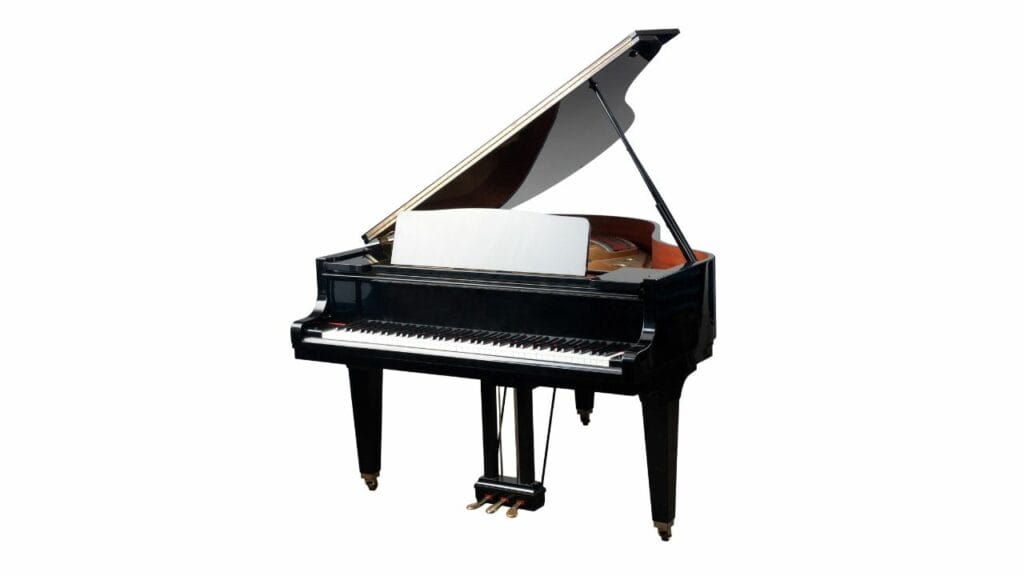
Musical instruments and musical theory are both complex subjects, and the various parts of a grand piano are no exception. This is because they have more strings and mechanisms to propel the hammers and drive them down onto the action. These components include:
Inner Frame
The inner frame dictates the stability of the soundboard. It is made of wood, steel, or sometimes cast iron. If a metal frame is used, it is made out of steel. The inner frame holds the strings attached to their tuning pins at each end. It also acts as a support to the cast iron plate.
Piano Action
The piano action is responsible for pushing the hammers downward onto the strings, thus propelling them forward and causing them to strike the strings. The piano action is attached to a series of levers and wires that are, in turn, connected to the keyboard. When a key is pressed, it activates any combination of keys, which pushes down the levers, activating wires that ultimately move a hammer. This action propels it forward and causes it to strike a string.
Hammers
Upright pianos have one hammer for each string. The hammers strike the strings from above, causing them to vibrate. On the other hand, Grand pianos have three hammers for each string. Piano hammers strike the strings from either side, causing the strings to vibrate more intensely and producing a richer sound. If the middle hammer does not strike a string, it will produce a sharp sound.
Dampers
Grand pianos have dampers in between the hammers and strings. The dampers work by closing off air passages to decrease the resonance of the strings being played; this causes these strings to go silent and gives you more control over dynamics and tone color. The music stops once the key is released. On the other hand, upright pianos do not have dampers. They rely instead on the physical force of a hammer to stop vibrations from sound once you release a key.
Bass and Treble Bridge
The bass and treble bridge allows musicians to adjust the tone by blocking or opening the dampers. This is done with the aid of a key on your left. You push the key down towards you, and it will open up or close down one of the dampers. This allows you to control sound volume by decreasing or increasing resonance, thus giving you more control over dynamics and tone color.
Treble Strings
Treble strings are the two sets of strings located closest to the bridge. The strings are made of nylon and brass, producing high-pitched sounds. They also serve an essential function in allowing the wooden soundboard to vibrate as it should, thus creating good-quality sound. When the key designated for the treble strings is pushed down, it will strike the strings. Once you release the key, it will return to its original position and strike the strings again.
Pedals
The pedals for a grand piano are the same as that of an upright piano. They are the una corda, sostenuto, and damper pedals. The leftmost pedal is the una corda, while the middle pedal is the sostenuto. The last one is the damper pedal.
Soundboard
The soundboard is essential in determining the quality of sound produced by all the piano parts. The soundboard is made out of spruce wood, a hardwood similar to maple, with a shiny surface that enhances tonal quality.
This part is exceptionally sturdy and robust enough to support heavy strings. It also provides structural support to the piano and holds specific components responsible for producing the intended sound.
Table of Contents


